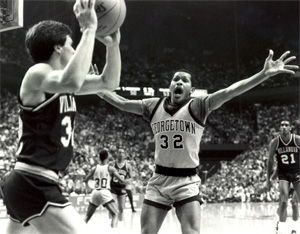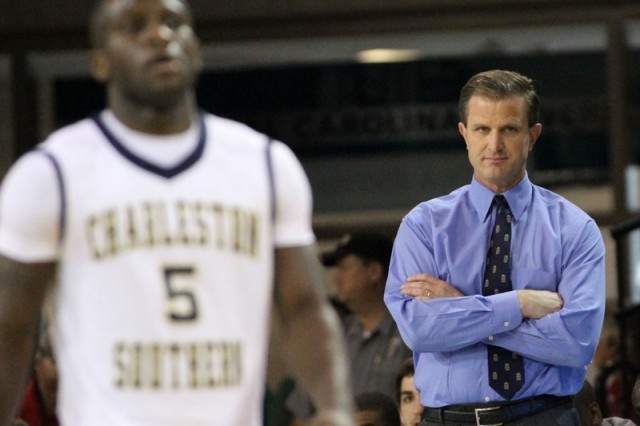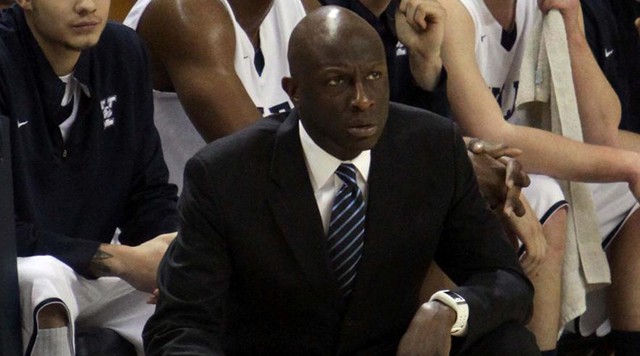When only 128 people hold a specific job position on the planet, one can reasonably say that such a job is rather exclusive. Such is the case for head coaches of Football Bowl Subdivision programs.
If 351 people hold a specific job, it’s not as though the position is terrifically expansive or widely available. Yet, compared to 128, the number reflects a very different reality.
*
See the person in the cover photo for this story? That’s James Jones of Yale. He’s been with the program since 1999. February 20 marks his 52nd birthday. You could say he’s committed the prime years of his adult life to Yale basketball.
He doesn’t have a single NCAA tournament appearance on his career resume.
Except for an extremely rare case now and then — almost surely due to presiding over a transition from the FCS or from independent status to life in a conference (or both) — you would not see this in college football. A coach generally wouldn’t be allowed to stand on the sidelines for a decade and a half without a bowl game, even at a lower-tier program and a generally thankless job. Football, in terms of both revenue and prestige, is too central in our culture to allow for prolonged drift and stagnation.
In basketball, however, the volume of competition in Division I not only means more jobs. The size of Division I relative to the Football Bowl Subdivision means that a lot of athletic programs simply can’t expect to be great — or even very good — in most years. Too many programs don’t have the resources to compete with the vigor they might want to display in an ideal world. In the lower tiers of D-I college basketball, constraints and concerns not belonging to the power conferences create a very different world. Within this separate realm, a number of coaches can — and do, and will — spend the prime years of their lives trying (and failing) to make the NCAA tournament just once.
One must hasten to say: Failure, at this level, is not a verdict on coaching ability or acumen. These coaches are taking on the hardest tasks in Division I basketball. They are coaching for love of the game, for the thrill of the challenge, and for the satisfaction of being able to mold young people into better players… maybe even citizens if they are fortunate enough.
These coaches aren’t making millions of dollars, and those at the bottom of the food chain aren’t even making six figures. Yet, the idea of being able to coach college basketball for a high-five-figure salary, with a certain degree of job security and some freedom from the W-L columns on an annual basis, doesn’t seem like a bad way to go through life. A lot of people would trade places and take on the job of coaching Savannah State. (Some wouldn’t, but many would.)
Just exactly who are these people? Let’s put a little flesh on the bone and define what it is to be a basketball lifer.

Horace Broadnax played on Georgetown’s Final Four teams during the Hoyas’ glory days in the 1980s. He now coaches at Savannah State. He’s been with the Tigers for just over a decade, and he’s been a head coach for nearly 20 seasons without an NCAA tournament appearance. Fire him? No, that’s not how college basketball (often) works in its lower tiers… appropriately so.
If you’re intimately familiar with the workings of college basketball, the following won’t surprise you, but if you are just trying to find your bearings after the Super Bowl and the Australian Open and the NBA All-Star Game (etc.), this fact might jump out and grab you: There are 20 Division I coaches who:
A) are at least 50 years old;
B) were hired by their current employers in the previous decade (2009 or earlier);
and C) have not made an NCAA tournament appearance with that school.
They’re still on the job, and some of them did make the NCAAs at previous coaching stops. Nevertheless, they are “O-fer” with their present programs, and they’re not moving. No one’s firing them (though one or two might actually be in danger of losing his job next month).
Let’s pare down that number (20) and reduce it to the amount of coaches who have never made an appearance in their classification’s national championship tournament at any previous head-coaching gig: 7.
Of the 20 coaches referred to above, 13 made appearances in an NAIA, NCAA Division II, or NCAA Division III national championship tournament. Therefore, seven men have coached since at least 2009 (if not longer) with their respective programs; are at least 50 years old; and have never, ever tasted what it’s like to achieve one’s foremost professional goal as a head coach.
Even if the pay is decent; even if the interactions with young men are rewarding; even if getting out of bed every morning elicits a smile, the competitor — the most aspirational element — inside every human person has to make those men hunger for just one taste of the big time. These coaches stand in liminal space, caught between the allure of a dream job (really, it is a dream job relative to most of us) and the reality of toiling in obscurity with little tangible reward. The value and satisfaction of this line of work must come within the soul, from one’s very bones and marrow.

Barclay Radebaugh of Charleston Southern is one of the seven D-I men’s head basketball coaches to have never reached a national championship postseason tournament in his career, while having coached at his present school for at least seven seasons (2009) and being at least 50 years old. It is one of the great — though rarely-seen — dramas of college basketball: Will lifer coaches at the lower levels of the sport ever get their one taste of glory?
James Jones and Yale do not have a conference tournament. You can cheer on the Bulldogs within the context of the Ivy League regular season. When you pick out small schools to root for in the upcoming conference tournaments (they’re just two weeks away!), root for the seven coaches other than Jones who have given their lives to the game and, in their fifties, have traveled too many miles to do anything else in second or third acts of their professional careers:
* Horace Broadnax, Savannah State
* Barclay Radebaugh, Charleston Southern
* Brian Katz, Sacramento State
* Don Verlin, Idaho
* Tom Moore, Quinnipiac
* Dave Simmons, McNeese State
These coaches might not be the Magnificent Seven, but they deserve the respect of everyone who knows what it’s like to do a difficult job and exist in a position which won’t elicit many thundering cheers from throngs of adoring fans.

